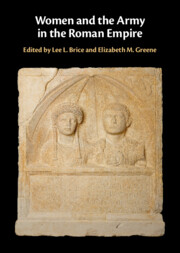Book contents
- Women and the Army in the Roman Empire
- Women and the Army in the Roman Empire
- Copyright page
- Dedication
- Contents
- Figures
- Maps
- Tables
- Contributors
- Acknowledgments
- Abbreviations
- Maps
- 1 Present but not Accounted For
- 2 Approaches to Women and the Roman Army
- 3 Agrippina and Company
- 4 Elite Marriage and Adultery in the Camp
- 5 Mother Courage and Her Children
- 6 Investigating Roles for Women inside Roman Military Bases through Artifact Distribution
- 7 (In)Visible Women and Children
- 8 Soldiers’ Wives en Route in Roman Egypt
- 9 The Role of Women in the Religious Activities of Roman Military Communities
- 10 Mater Castrorum
- 11 Women and the Military in the Age of Justinian
- Index
- References
7 - (In)Visible Women and Children
Literary, Epigraphic, and Archaeological Evidence for British Migrant Families in the Roman Army
Published online by Cambridge University Press: 24 October 2024
- Women and the Army in the Roman Empire
- Women and the Army in the Roman Empire
- Copyright page
- Dedication
- Contents
- Figures
- Maps
- Tables
- Contributors
- Acknowledgments
- Abbreviations
- Maps
- 1 Present but not Accounted For
- 2 Approaches to Women and the Roman Army
- 3 Agrippina and Company
- 4 Elite Marriage and Adultery in the Camp
- 5 Mother Courage and Her Children
- 6 Investigating Roles for Women inside Roman Military Bases through Artifact Distribution
- 7 (In)Visible Women and Children
- 8 Soldiers’ Wives en Route in Roman Egypt
- 9 The Role of Women in the Religious Activities of Roman Military Communities
- 10 Mater Castrorum
- 11 Women and the Military in the Age of Justinian
- Index
- References
Summary
This chapter explores the topic of Roman military families’ mobility in the late first through third centuries CE by discussing a case study of British families abroad. It surveys the evidence for families that came from Roman Britain and settled on the continent. In doing so, the author assesses and compares various types of evidence (literary, epigraphic, and archaeological) to discuss the case of British military families on the move, families that had been present in the Roman Empire but not accounted for in the modern scholarly literature. The sources analyzed include literary texts, inscriptions, military diplomas and personal dress accessories that the members of such families took with them as part of personal possessions during their travels. Since most sources available to trace such families come from the Roman military context, the focus lies on emigrant soldiers’ families. The first section relies heavily on the historical texts and epigraphic material while the second part is devoted to the discussion of the potential and limitations of material culture in our search for migrant communities. The chapter provides a case to support the view that British military families traveled far and wide in the empire.
- Type
- Chapter
- Information
- Women and the Army in the Roman Empire , pp. 181 - 218Publisher: Cambridge University PressPrint publication year: 2024

